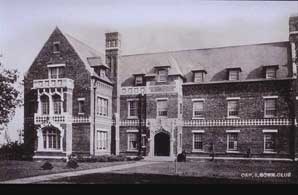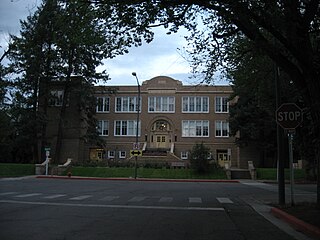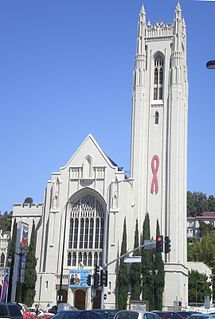
First Baptist Church is one of six national historic landmarks in Columbus, Indiana. It was designed by distinguished architect Harry Weese; construction was completed in 1965. Since completion, few alterations have been made and the building has retained its integrity.

Cap and Gown Club, founded in 1890, is an eating club at Princeton University, in Princeton, New Jersey, United States. Colloquially known as "Cap", the club is one of the "Big Four" eating clubs at Princeton. Members are selected through a selective process called bicker. Sometimes known as "the Illustrious Cap and Gown Club," it was the first of the currently selective eating clubs to accept women. Though personalities of eating clubs certainly change throughout the years, Cap and Gown is described in F. Scott Fitzgerald's This Side of Paradise as "anti-alcoholic, faintly religious and politically powerful."

The University Cottage Club is one of eleven current eating clubs at Princeton University, in Princeton, New Jersey, United States. It is also one of the six bicker clubs, along with The Ivy Club, Tiger Inn, Cap and Gown Club, Cannon Club and Tower Club.

Rutherford is a New Jersey Transit railroad station served by the Bergen County Line. The station straddles the border between Rutherford and East Rutherford in Bergen County, New Jersey, United States. The station building and Hoboken Terminal-bound platform is located near a traffic circle at the junction of Park Avenue, Union Avenue, Erie Avenue and Orient Way known as Station Square, with a grade crossing on Park Avenue. The tracks serve as the border between the two municipalities and the Suffern-bound platform is actually located in East Rutherford along with its parking lot.

The Watchman Lookout Station No. 168 is one of two fire lookout towers in Crater Lake National Park in southern Oregon. For many years, National Park Service personnel used the lookout to watch for wildfires during the summer months. It is also a common hiking destination because of its views of Crater Lake and the surrounding area. The building is unusual because it serves the dual purpose of fire lookout and museum. The Watchman Lookout Station is listed on the National Register of Historic Places.

Rim Rock Drive is a scenic road in Colorado National Monument. The 23-mile drive follows the upper rim of a series of canyons, extending from the vicinity of Fruita, Colorado in the west to near Grand Junction, Colorado in the east, connecting points only eight miles apart in a straight line. The entire road has been designated a historic district on the National Register of Historic Places.

This is a list of the National Register of Historic Places listings in El Paso County, Colorado.
This is a list of the National Register of Historic Places listings in Downtown Denver, Colorado.

The University of Arkansas Campus Historic District is a historic district that was listed on the National Register of Historic Places on September 23, 2009. The district covers the historic core of the University of Arkansas campus, including 25 buildings.

The Building at 202 W. Third Street is a historic building located in downtown Davenport, Iowa, United States. It has been listed on the National Register of Historic Places since 1983.

The Outing Club is located in the central part of Davenport, Iowa, United States. It has been listed on the National Register of Historic Places since 1977. In 1985 it was included as a contributing property in the Vander Veer Park Historic District.

The Wauwatosa Woman's Club Clubhouse is located in Wauwatosa, Wisconsin. It was added to the National Register of Historic Places in 1998.

The First Congregational Church in Colorado Springs, Colorado is a historic church at 20 East Saint Vrain Street. It was listed on the National Register of Historic Places in 2002.

With this motto, “The measure of the worth of an organization to its community, is bound in its ability to embrace opportunities for service” the Twentieth Century Club had its beginning in 1894. Mrs. Walter McNab Miller served as President for an original group of 84 women. The Club's name was chosen to reflect a look forward to the future and the beginning of the new century.

Durango High School, also known as the Durango 9-R Administration Building, is a former school in Durango, Colorado. It is listed on the National Register of Historic Places and the Colorado State Register of Historic Properties. The building opened in 1917, and served as a high school until 1976, after which it became the district administration building.

Wildwood Park Historic District is a nationally recognized historic district located in Charles City, Iowa, United States. It was listed on the National Register of Historic Places in 1998. At the time of its nomination it consisted of 26 resources, which included three contributing buildings, one contributing site, nine contributing structures, one contributing object, seven non-contributing buildings, and five non-contributing structures.

The Port Arthur Federated Women's Clubhouse, at 1924 Lakeshore Dr. in Port Arthur, Texas, is a women's club building which was built in 1924. It has also been known as The Department Clubhouse. It was listed on the National Register of Historic Places in 1985.

The Women's Civic Improvement Clubhouse, at 59 Winburn Way in Ashland, Oregon, was built during 1921-22. Its construction was funded by the Ashland Women's Civic Improvement Club and the philanthropy of Jesse Winburn. It was listed on the National Register of Historic Places in 1989.

The Glendale Woman's Club was organized in 1912 with 85 members. It took over the local library in 1918, which had been neglected during World War I, and, even after the library was moved to a municipal building, the club served the library until 1922. The Glendale Woman's Club is a member of the General Federation of Women's Clubs.


























